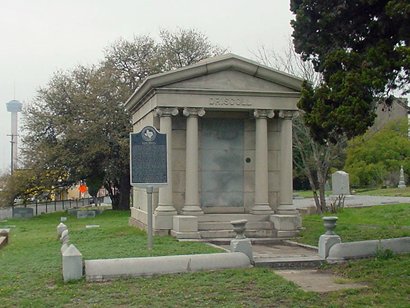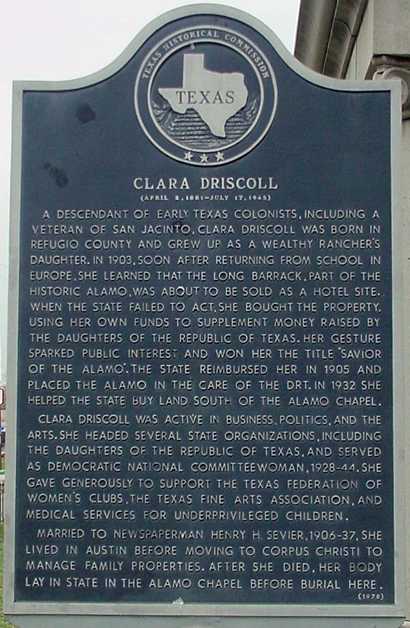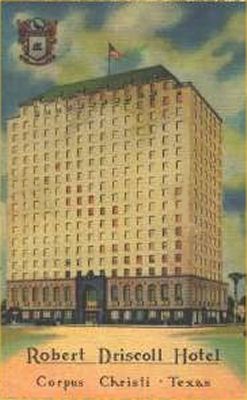|
|
 |
Historical
Marker:
Clara Driscoll
(April 2, 1881-July
17, 1945)
A descendant of early Texas colonist, including a veteran of San
Jacinto, Clara Driscoll was born in Refugio County and grew up
as a wealthy rancher's daughter. In 1903, soon after returning from
school in Europe, she learned that the Long Barrack, part of the historic
Alamo, was about to
be sold as a hotel site. When the state failed to act, she bought
the property, using her own funds to supplement money raised by the
Daughters of the Republic of Texas. Her gesture sparked public interest
and won her the title "Savior of the Alamo." The state reimbursed
her in 1905 and placed the Alamo
in the care of the DRT. In 1932 she helped the state buy land south
of the Alamo Chapel.
Clara Driscoll was active in business, politics, and the arts. She
headed several state organizations, including the Daughters of the
Republic of Texas, and served as Democratic National Committeewoman,
1928-44. She gave generously to support the Texas Federation of Women's
Clubs, the Texas Fine Arts Association, and medical services for underprivileged
children.
Married to newspaperman Henry H. Seveir, 1906-37, she lived in Austin
before moving to Corpus
Christi to manage family properties. After she died, her body
lay in state in the Alamo Chapel before burial here. |
 |
Clara Driscoll
historical marker
TE photo |
The
Alamo
Postcard courtesy www.rootsweb.com/%7Etxpstcrd/ |
From
The
Second Battle of the Alamo
by C. F. Eckhardt
It might come as a surprise to many Texans that there were two ‘battles
of the Alamo.’ There was the
one in February and March of 1836, and then there was one that
lasted for nine years—from 1903 to 1912.
I really don’t like to write about the Alamo.
Not that I don’t appreciate what its significance for Texas
is--I can’t read Travis’s last letter on the wall there without tears
coming to my eyes, and I know what a first-water (expletive deleted)
he was in his personal life. Still, everybody’s written about the
Battle of the Alamo—the
first one, that is. Not many folks have written about the second one.
Texas
didn’t do much with the building. There was no restoration, no effort
even to preserve the crumbling walls. The state owned it, it was there,
that was it. Title to much of the land to the north of the chapel,
where the old convento stood, was held, in the 1890s, by Hugo
& Schmeltzer, a firm of wholesale merchants. They had a huge frame
warehouse and salesroom built adjacent to the chapel and at least
some of their offices were in the convento.
In 1903 Hugo & Schmeltzer was closing its doors for good and selling
off its assets—one of which was the land to the north of the chapel.
About three years earlier a young woman named Clara Driscoll,
whose grandfather, Daniel Driscoll, was a San
Jacinto veteran, returned to Texas
after spending seven years in school in Europe. Clara was impressed
with the way Europeans preserved and protected their historical sites.
When she saw the condition of the Alamo chapel and the land where
the battle was fought, she was furious. She began a letter-writing
campaign to newspapers around the state. The objective was the preservation
of the Alamo chapel and as much of its grounds as possible. She joined
the DeZavala
Chapter of the Daughters of the Republic of Texas and immediately
began campaigning to acquire the Hugo & Schmeltzer property to add
to the Alamo chapel, in order to begin proper preservation of the
Shrine of Texas Liberty.
Now,
Clara was a salty ol’ gal, and there’s more than rumor that she liked
her nip—several of ‘em in succession. She lived much of her later
life in Corpus
Christi, and at one time—now demolished—there was a luxurious
hotel called the White Plaza ‘on the bluff’ in Corpus
Christi, overlooking the bay. Clara and several cohorts tried
to check into the White Plaza one night and were refused registration
because, quite frankly, they were stewed to the gills and the management
thought they’d disturb the other guests.
“By God,” said Clara, “I’ll build a hotel right next to your damn’
hotel, an’ it’ll be bigger an’ finer’n your damn’ hotel, an’ when
I get it finished I’ll spit on your damn’ hotel.” (For the record,
she didn’t say ‘spit,’ but that’s what the tour-guides have to say
she said.) She built the hotel—the Driscoll, which still stands as
an office building in downtown Corpus
Christi. It was right next door to the White Plaza. Atop the Driscoll,
attached to the penthouse, is a projection that overhung the roof
of the White Plaza. It was from that projection, so they say, that
Clara did what she said she’d do on the White Plaza—and she didn’t
say ‘spit.’ |
 |
The Robert Driscoll
Hotel
in Corpus
Christi
Postcard courtesy rootsweb.com/%7Etxpstcrd/ |
That
was a long time later—in 1903 Clara was simply a wide-eyed young lady
crusading for the preservation of what has become the single most
widely-visited historical site in Texas
and one of the most widely-visited in the US. She and members of the
DeZavala
Chapter, DRT, approached Hugo & Schmeltzer about selling the property
adjacent to and directly north of the chapel.
“Sure,” said Hugo & Schmeltzer. “You got seventy-five thousand bucks?”
The DeZavala
Chapter of the DRT didn’t have $75,000. Hugo & Schmeltzer was demanding
$5,000 for a one-year option, with an additional $20,000 to be paid
when the option expired and five annual installments of $10,000 at
6% interest to be paid over the next five years. The DeZavala
Chapter—and the DRT as an organization—started trying to raise the
money.
Almost immediately a new player entered the game. An eastern syndicate
wanted to buy the Hugo & Schmeltzer property for a hotel, and it was
offering better than $5,000 for a year’s option. Clara, together with
Judge James B. Wells of Brownsville
and Floyd McGown of San
Antonio, went directly to Charles Hugo, the surviving partner
of Hugo & Schmeltzer, to try to preserve the property for Texas. Hugo
agreed to give a 30-day option on the property for $500, cash on the
barrel, and an additional $4,500 to be paid in 30 days. Clara reached
into her purse, pulled out her checkbook, and wrote the $500 check
that ultimately preserved the grounds of the Alamo
as they are today.
The DeZavala
Chapter DRT immediately called for a statewide appeal to raise the
needed $4,500 by April 17, 1903—the day the option expired. Though
the legislature was in session, it declined to appropriate the money
to pick up the option. The DRT sent a delegation to the legislature—Clara
headed it—and an amendment was placed on an appropriations bill to
provide the $5,000 to pick up the option and reimburse Clara her $500.
Before the appropriations bill could pass the time ran out on the
30-day option. Rather than lose the property, Clara pulled out her
trusty checkbook and put up the remaining $4,500. The property was
safe for a year. The ladies waited for the legislature to act. The
bill passed—but Governor S. W. T. Lanham vetoed it. Clara was out
$5,000 and there was no guarantee the DRT could raise the $20,000
that would be due in a year, much less the $10,000 per year for the
next five years—plus interest—to complete the purchase.
By
February 10, 1904, the DRT had raised $5,666.23. The option was expiring
and the eastern syndicate was sitting in the wings with money to buy
the property for cash. Out came Clara’s checkbook again, and she wrote
a check for $14,333.77 to clinch the sale. She also signed, in her
own name, five notes for $10,000 each at 6% per annum to complete
the payment. She was now obligated for another $50,000 plus interest,
in addition to taxes and insurance on the property—all for ‘an unsightly
old pile of rocks.’ The deed of transfer included the words “This
property is purchased by Clara Driscoll for the use and benefit of
the Daughters of the Republic of Texas, to be used by them for the
purpose of making a park about the Alamo,
and for no other purpose.”
There’s
something peculiar about Texans—we
love a fighter. Our history—and our legends—are full of one-man—and
one-woman—fights for what the fighter though was right. Clara’s fight
to preserve the land around the Alamo
brought an immediate outpouring from around the state. Money rolled
in—and so did sympathy. By August, 1904, the Democratic State Convention
made purchase of the Alamo property a plank in the party’s platform.
On January 26, 1905, the 29th Legislature appropriated $65,000 to
complete the purchase of the Alamo property. Governor Lanham signed
the bill. The bill provided that the Daughters of the Republic of
Texas should be custodians of the property. Clara formally transferred
the property to the State of Texas and Governor Lanham conveyed custody
of the property to the DRT. Just in case you think the funds don’t
quite add up, the DRT raised $10,000 on its own—and yes, Clara got
her $19,333.77 back—but without interest.
The
purchases that would ultimately expand the Alamo
property into the park we know today had been made, but at terrific
cost. The DRT, as an organization, was nearly flat broke. Clara’s
magic checkbook had taken a tremendous beating. The very last thing
the DRT needed in connection with the Alamo
was an internal squabble-—the sort of thing that would cause the doomsayers
of Texas, of which we have never had a dearth, to say things like
“See, those derned ol’ women can’t even get ‘long amongst themselves.
How’re they gonna run the Alamo!”
Unfortunately, that’s just what they got.... more
See The Second
Battle of the Alamo for full story
© C. F. Eckhardt |
| Texas
Escapes, in its purpose to preserve historic, endangered and vanishing
Texas, asks that anyone wishing to share their local history, stories,
landmarks and vintage/historic photos, please contact
us. |
|
|
